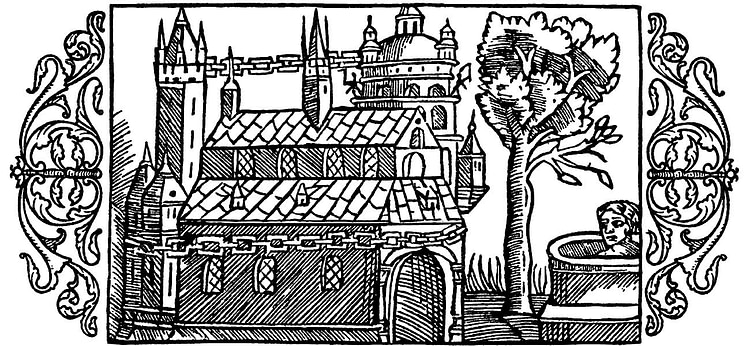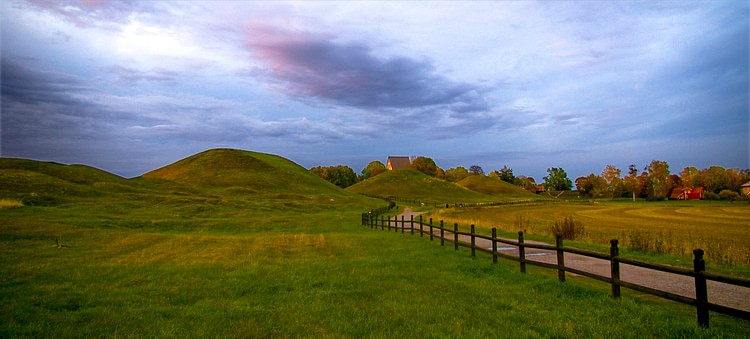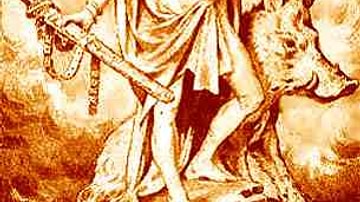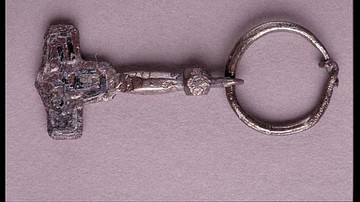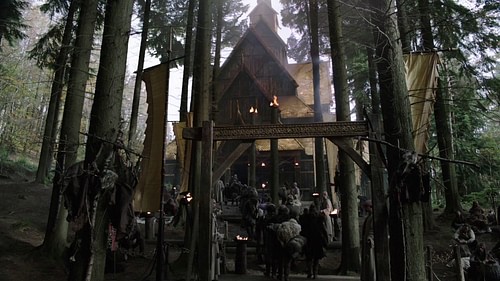
The Temple at Uppsala was a religious center dedicated to the Norse gods Thor, Odin, and Freyr located in what is now Gamla Uppsala in Sweden. It is described by the 11th-century historian Adam of Bremen as the most significant pagan site in the region and was destroyed by the Christian King Inge the Elder c. 1080.
The site is also referenced in the Ynglinga Saga of the Heimskringla written by the Icelandic mythographer Snorri Sturluson (l. 1179-1241) and the Gesta Danorum of Saxo Grammaticus (l. c. 1160 - c. 1220). In every case, it is associated with the gods of the Norse religion and in Adam and Saxo with human sacrifice. At the time Adam was writing (c. 1070), Christianity was still contending with the old Norse beliefs for supremacy in the region, while in Saxo’s time, it was more established. Both wrote from a Christian point of view and so cast the temple and its rites in a negative light. Sturluson was recounting ancient myths for his age and so humanized the gods, making deities like Odin into great kings of the past rather than gods and so avoided having to demonize the site for a Christian audience.
Sturluson’s treatment of Uppsala drew on folklore and legend which maintained that the three gods the site was sacred to – Thor, Odin, and Freyr – were buried there each under one of the Royal Mounds, three large burial mounds still extant. These mounds were later associated with the early kings of the Dynasty of the Ynglings and so linked them with the historical monarchy of Sweden. Excavations of the mounds and site in the 19th century proved them to be burial mounds for royalty, but the remains, some cremated, could not be identified. Still, linking the site with ancient kings, rather than gods, further distanced Uppsala from an association with Norse religion.
The site is thought to have been modeled on Norse cosmography as it had a sacred well beneath a great tree, mirroring the World Tree Yggdrasil, which contained the Nine Realms of Norse cosmology, rising above Urd’s Well (the well of fate), manifesting the invisible realm on the physical plane. The site continued its religious importance in the Christian era when a church was built on or near the location of the ancient temple, and Gamla Uppsala became the seat of the Archbishopric of Sweden up until 1273 when the seat was moved. Presently, the church is still in operation and the surrounding grounds are a popular park and tourist attraction.
Norse Cosmography & Religious Rites
In Norse belief, the visible world (Midgard) was only one of nine realms existing among the roots of the World Tree Yggdrasil. The Nine Realms were developed from an earlier vision by Sturluson, who added Hel and combined Nidavellir/Svartalfheim so that, by the 13th century, they were:
- Asgard – Realm of the Aesir, joined to Midgard by the rainbow bridge Bifröst
- Alfheim – Realm of the elves
- Hel – Realm of those who died of illness or old age and then of most people
- Jotunheim – Realm of the giants and frost giants
- Midgard – Realm of the humans between Asgard and Jotunheim
- Muspelheim – Realm of fire, the fire giant Surtr, and Surtr's forces of chaos
- Nidavellir/Svartalfheim – Realm of the dwarves beneath the earth
- Niflheim – Realm of ice, snow, and mist near Muspelheim
- Vanaheim – Realm of the Vanir
At the beginning of time, only Yggdrasil existed, growing from the misty void of Ginnungagap which was bordered by the fiery realm of Muspelheim and the icy world of Niflheim. The fires of Muspelheim began to melt the ice of Niflheim, and the giant Ymir emerged along with the cow Audhumla who began licking the ice and revealed the god Búri. Búri mated with the giantess Bestla who gave birth to the gods Odin, Vili, and Vé. Ymir, after self-fertilizing, gave birth to the giants.
The gods killed Ymir and the other giants except two, Bergelmir and his wife, whose offspring would become the enemies of the gods. After their victory, the gods created the other realms and the first humans – Ask and Embla – establishing order over the primordial chaos. Midgard was connected to Asgard by the bridge Bifröst, allowing the gods easy access to the world so they could quickly respond to any threats to their human creations. Prior to making any important decisions regarding humans or anything else, the gods would confer at Urd’s Well, a spring in the roots of Yggdrasil near the hall of the Norns (Fates) who wove the destinies of all things. The Norns were Urd, Verdandi, and Skuld, and their decisions could not be reversed.

The Norns had decreed that the gods of Asgard would only reign for a time before they and their worlds were destroyed when the forces of chaos broke free at Ragnarök. All the other realms beside Midgard and Asgard – located either underground or in remote areas – were equally accessible and interdependent to greater or lesser degrees and so all would finally be destroyed when the forces of the trickster god Loki met the gods of Asgard in battle. When this time came, humans would be able to recognize its approach by various signs in nature and their own behavior. The visible world was therefore closely connected to the unseen, and the earth was thought to be filled with all kinds of supernatural entities.
These beings needed to be honored – or placated – and Norse religious rites developed for this purpose. It is unclear what these rites were as the Norse had no written tradition, and the stories of the gods, as well as the rituals honoring them, were passed down orally through the generations. When Christianity became the dominant religion in Scandinavia, Iceland, and elsewhere, the tales were written down – usually to disparage the old faith as contrasted with the new – and reference was made to ancient rituals by Christian scribes trying to discredit them. Among these accounts is Adam of Bremen’s description of Uppsala which highlights human sacrifice and references "unseemly" incantations to emphasize the barbarity of the Norse religion as compared with Christianity.
Adam of Bremen’s Description
Adam of Bremen’s account of the Uppsala temple is far more detailed than other references to the site but, as he was writing from a religious understanding he felt was superior to paganism, includes only what serves his needs. Adam was not trying to provide an objective report on the temple, or the rites observed there, but to show how inferior the old faith was to Christianity. Almost by accident, he left behind the most complete description of the Temple at Uppsala extant:
That folk [the Swedes] have a very famous temple called Uppsala, situated not far from the city of Sigtuna and Bjorko. In this temple, entirely decked out in gold, the people worship the statues of three gods in such wise that the mightiest of them, Thor, occupies a throne in the middle of the chamber; Wotan [Odin] and Frikko [Freyr] have places on either side. The significance of these gods is as follows: Thor, they say, presides over the air, which governs thunder and lightning, the winds and rains, fair weather and crops. The other, Wotan – that is, the Furious – carries on war and imparts to man strength against his enemies. The third is Frikko, who bestows peace on mortals. His likeness, too, they fashion with an immense phallus. But Wotan they chisel armed, as our people are wont to represent Mars. Thor with his scepter apparently resembles Jove. The people also worship heroes made gods, whom they endow with immortality because of their remarkable exploits, as one reads in the Vita of Saint Ansgar, they did in the case of King Eric.
For all their gods there are appointed priests to offer sacrifices for the people. If plague and famine threaten, a libation is poured to the idol of Thor; if war, to Wotan; if marriages are to be celebrated, to Frikko. It is customary also to solemnize in Uppsala, at nine-year intervals, a general feast of all the provinces of Sweden. From attendance at this festival no one is exempted. Kings and people all and singly send their gifts to Uppsala and, what is more distressing than any kind of punishment, those who have already adopted Christianity redeem themselves through these ceremonies. The sacrifice is of this nature: of every living thing that is male, they offer nine heads, with the blood of which it is customary to placate gods of this sort. The bodies they hang in the sacred grove that adjoins the temple. Now this grove is so sacred in the eyes of the heathen that each and every tree in it is believed divine because of the death or putrefaction of the victims. Even dogs and horses hang there with men. A Christian told me that he had seen 72 bodies suspended promiscuously. Furthermore, the incantations customarily chanted in the ritual of a sacrifice of this kind are manifold and unseemly; therefore, it is better to keep silence about them. (Book 4.26-27, Somerville & McDonald, 65-66)
The Scholium (marginal note) numbers 134 and 135 (often given as Book 4.28) provides a description of the great tree that stood near the temple as well as its location in a central plain surrounded by mountains:
Near this temple stands a very large tree with wide-spreading branches, always green winter and summer. What kind it is nobody knows. There is also a well at which the pagans are accustomed to make their sacrifices and to plunge a live man into it. If he is not found, the people’s wish will be granted.
A golden chain goes round the temple. It hangs over the gable of the building and sends its glitter far off to those who approach, because the shrine stands on level ground with mountains all about it like a theater. (Simek, 340-341)
The Uppsala temple according to Adam was the most significant in the region and may have been the only one. Religious rituals were usually observed in sacred groves, by streams, on various elevations, wherever a spiritual resonance was detected, even in one’s home, as noted by scholar Preben Meulengracht Sorensen:
The most important difference between pagan and Christian worship was that pagan cults did not have the regular organization of the Christian church. Religion was not a separate institution with special temples and priests. It was part of ordinary life and maintained by individual members of society, that is, by yeomen and housewives, and the rituals were performed in the homes of farmers and chieftains. (Sawyer, 213)
Even at Uppsala, according to Adam, the well beneath the tree at the temple and the sacred grove adjoining it played as important a role in ritual as whatever rites were performed indoors. Further, it is unknown what form the temple took as Adam only notes it housed the statues of Thor, Odin, and Freyr and so it could have been an open-air sanctuary allowing an officiant to draw on the elemental powers of earth and sky.
Reliability of Account
Adam’s account is thought to be derived from a second-hand source, and few scholars accept the whole of it. It has been suggested that Adam wrote his description largely from his own imagination from meager details received from a Christian he met during his travels. Although some scholars accept the validity of the 72 bodies hanging from trees, that line can also be translated as "a Christian 72 years old told me that he had seen their bodies suspended promiscuously" (Somerville and McDonald, 66). Adam’s claim that people gathered every nine years has also been challenged as eight years seems more likely and the claim that Christians had to "redeem themselves" (pay a certain amount) to avoid attendance has been challenged as well. Scholar Rudolf Simek comments:
Adam’s sources for this information are of extremely varying reliability, but the existence of a temple at Uppsala is undisputed. The details have often been questioned as some influences from the descriptions of the Temple of Solomon in the Old Testament have been assumed, but the chain mentioned has counterparts in European churches of the 8th and 9th centuries, even if the idea that it was made of gold is an exaggeration. (341)
Overall, Adam’s account is accepted as it is the most detailed extant and various aspects – such as the tree-and-well symbolism, the roles of the gods, the sacred grove, and the festival – are established elsewhere. Later writers do not provide the kind of detail Adam does but still emphasize the importance of the site and its association with the gods.
Sacred Center
The site was most likely chosen by adherents of the Norse religion for its spiritual resonance and may have been seen as a nexus between the seen and unseen realms. Scholar H. D. Ellis Davidson notes how the tree at Uppsala was a reflection of Yggdrasil and part of a sacred grove often associated with pre-Christian Norse rituals which were observed at a sacred center, commenting:
As the center of the cosmos, the sacred place was linked with creation legends; it was also a spot where communication with the powers of the Other World might take place. (25)
Uppsala as a sacred center is echoed in the works of Saxo and Sturluson, who both associate the site with Odin and Freyr. Both writers claim that Odin was a king of such great renown that, when he died, the people deified him. Saxo claims that Odin the king "falsely claimed of godhead" resided at Uppsala before Freyr lived there and instituted the ritual of human sacrifice (Book I). Sturluson suggests King Odin was buried there after he fell ill and died in Sweden. Afterwards, Sturluson writes:
[After Odin died,] the Swedes got it into their heads that he had gone to the ancient Asgard and that he would live there forever. So they renewed their faith in Odin and said prayers to him. (Ynglings 26.9; Somerville & McDonald, 71)
Sturluson thereby explains how the site was associated with the ancient gods without having to make any statement concerning their validity; peoples’ belief that a great man had become a god did not mean anything like that happened and so the site could be honored by Christians without compromising their faith. Sturluson’s efforts suggest he was trying to maintain the image of Uppsala as a sacred center without having to associate it with the old gods.
Conclusion
Burials at the site also suggest it was understood as a sacred center as there were once nearly 3,000 mounds and cairns located in and around Uppsala, most now destroyed by development. The Royal Mounds, whose image has become synonymous with the site (and with Sweden), were originally considered the tombs of Thor, Odin, and Freyr before the 19th century when they were redefined as the tombs of the kings of the Ynglinga Dynasty.
These legendary kings served the same purpose as the gods in connecting the people with other realms and inspiring them by great deeds. The definition of other realms and great deeds may have changed with the coming of Christianity but the importance of Uppsala had not. Even so, in c. 1080, the Christian King Inge of Sweden (d. c. 1105) is said to have destroyed the temple as part of his purge of "wizards and witches" of the old religion – for which he seemed to think he would be thanked – and was afterwards forced to abdicate after being pelted with stones. The Christians took over the site sometime in the late 11th or early 12th century and built a church there, most likely cutting down the sacred tree as they had done at pagan sites elsewhere.
They continued the site as an important religious center, however, after the old gods and their traditions had been replaced by a new understanding of the human relation to the divine. In the present day, a quiet stone church sits near to where the temple is thought to have stood and people ride bicycles to the surrounding park where, according to Adam of Bremen, the great festival was once held and human sacrifices dangled from the limbs of trees. How much of his report is accurate is nearly impossible to say, but his images have become the only history of the once famous temple at Uppsala.
